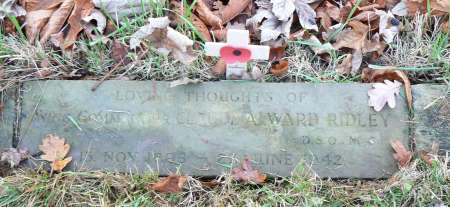Claude Alward Ridley
Claude Ridley was born on 15
November 1896 in Sunderland as the third child of wealthy parents
Louis and Eleanor Ridley.
His parents moved to London
where they lived in fashionable Royal Crescent at Notting Hill.
He attended St Paul's
School in London and then Sandhurst College as a Cadet.
On the outbreak of the war he
received a temporary commission into the RFC although this was short
lived as he resigned when offered a full commission at RMC
Sandhurst.
After passing out he joined
the Royal Fusiliers but continued his interest in flying by becoming
attached to the RFC in 1915.
He joined 3 Squadron in
France where he soon engaged in battles with the Germans and
inevitably in August 1915 during a fight with 2 German planes he was
wounded in the foot which meant that he was no longer able to fly
and returned to the UK for convalescence.
Once fit to fly he was posted
to one of the new London defence airfields at Joyce Green to deal
with Zeppelin raids.
C. Cole and E.F. Cheesman in The
Air Defene of Britain 1914-1918 provide an account of a zeppelin
raid on the night of 31 March/early hours of 1 April 1916..
Seven German Navy Zeppelins
set out to bomb London. The raid soon ran into trouble when two
returned with mechanical troubles and then three Army Zeppelins
returned because of bad weather.
The remaining three pressed
on into England with two crossing the Suffolk coast and one
crossing the Norfolk coast causing havoc with sighting and bombs all
over East Anglia.
Zeppelin L15 continued
towards London on a path that took it near to Joyce Green.
Ridley took off in his BE2c
and then caught a glimpse of the Zeppelin in a searchlight. He
started to fire his machine gun at the Zeppelin and closed the
distance but as he did so the Zeppelin moved out of the searchlight
and was lost by Ridley.
A few minutes later over
Purfleet the Zeppelin was again picked out by a searchlight and an
anti aircraft battery made a direct hit splitting the fabric of the
airship and allowing gas to escape. Once again the zeppelin was lost
but badly damaged it crashed into the sea off Margate.
The London Gazette on 16 May 1916 records the award of a Military Cross for conspicuous gallantry and good work during zeppelin raids
.
 Ridley
in his Morane Bullet with 60 Squadron in France from the book 60
Squadron
Ridley
in his Morane Bullet with 60 Squadron in France from the book 60
Squadron
Ridley now moved back to
France with the new 60 Squadron where he became the expert in the
perilous job of flying spies into German occupied territory at
night. This was a dangerous task as he had to reconnoitre the area
in daylight before the landing and choose a suitable grassy field
from the area. A night or so later he would take off at night with
the spy and return to his selected field where he would land, drop
off the spy and take off again.
60 Squadron were equipped
with French built Morane Bullets. These were quite fast with a
capability of 90mph but at that speed the machine gun would refuse
to fire and at lower speed the plane was very unstable liable to
stall and spin on any manoeuvre other than blatant fast straight
flying.
On 3 August 1916 Ridley took
off with his spy and landed in his chosen field near Douai. Two bad
things happened firstly the Germans had that day taken over a nearby
filed as a temporary airfield and secondly his engine died and he
was unable to take off again.
The book 60 Squadron by
Group Captain AJL Scott tells the story of what happened next-
His
adventures were remarkable. His spy got out, told Ridley to hide for
a little, and presently, returning with civilian clothes and some
money, told him that he must now shift for himself.
Ridley did so with such address that he eluded capture for three
months on the German side of the line, and eventually worked his way
via Brussels to the Dutch frontier and escaped.
This
was a good performance, none the worse because he could speak
neither French nor German. The method he adopted was a simple one he
would go up to some likely-looking civilian and say, “I am a British
officer trying to escape; will you help me?”
They
always did. He had many interesting adventures. For example, he lay
up near the Douai aerodrome and watched the young Huns learning to
fly and crashing on the aerodrome where he saw one of our B.E.s
brought down, and the pilot and observer marched past him into
captivity; later the conductor of a tram in the environs of Brussels
suspected him, but, knocking the man down, he jumped into a field of
standing corn and contrived to elude pursuit.
This exciting account was
similarly recorded by Ralph Barker in his book The Royal Flying
Corps in France and other similar accounts at the time helping
to build a great reputation for Ridley it is at odds to the account
recorded by Ridley himself in documents held by the National
Archives. We do not know the sources used by Barker and Scott so it
seems best to follow the account attributed to Ridley himself.
According to Ridley's account
the agent, known only as V.M., did not tell Ridley to shift for
himself. A friend of V.M. gave Ridley civilian clothing and V.M.
stayed with Ridley until his attempted arrest on the tram on
September 30th. Ridley recorded his indebtedness to V.M. at the end
of his account.
Ridley was after that alone
until he met Landers, a Belgian fugitive on October 3rd, with whom
he eventually crossed the frontier.
It is unlikely that Ridley
introduced himself as British officer trying to escape, when he was
on the run with the agent in occupied Belgium. The agents’ mother,
sister and V.M.'s former comrades had been arrested. Ridley recorded
a number of occasions then, and later when he was alone, of
refusals help. The 'standing corn' story may be the garbled version
of Ridley's appeal to a man who was loading a cart with corn
to let him hide in it - he was refused.
Whatever account is correct
Starting with the new aerodrome near to his crash Ridley kept notes
of all enemy activity and on his eventual escape via the neutral
Netherlands he was able to supply good information.
On 14 November 1916 the
London Gazette records the award of a Distinguished Service Order
for conspicuous gallantry and judgment in the execution of a
special mission. When his machine was wrecked he used great resource
and obtained valuable information.
It is rumoured that Ridley
had a personal audience with the King to congratulate him on his
escape.
Ridley returned to his
Squadron in France but he was not allowed to fly as were he to crash
behind German lines then he would be shot as a spy given his actions
while he was on the run.
 Stow
Maries aerodrome before restoration.
Stow
Maries aerodrome before restoration.
In view of that, at the age
of 19, he returned to the defence of London and in November 1916 he
was given command of B Flight 37 Squadron at its new base at Stow
Maries.
Although no doubt he was
frustrated not to return to his front line squadron, given the life
expectancy of a front line pilot at about 6 weeks, the posting may
well have helped him live through the war.
In 1928 following postings at
several stations, including a spell at the 2nd flying training
school at RAF Digby in Lincolnshire, he retired with the rank of
Squadron leader but the new conflict saw him back in uniform
although now with the rank of Wing Commander.
Despite leaving Stow Maries
in July 1917 after less than a year, Ridley maintained an attachment
to the village.
In June 1925 he married
Lilias Elizabeth McAlpine, granddaughter os the well know contractor
Sir Robert Alpine, at St Marks in Audley Street, London with a
reception at Claridges Hotel. Such was his standing that no fewer
than 3 air commodores were guests at the wedding.
Valerie Lloyd George,
Granddaughter of former Prime Minister David Lloyd George carried
the brides silver lame train.
Ridley was a keen sportsman
listing hunting, steeplechasing, polo, boxing and rugby amongst his
sporting interests.
In 1925 he donated an
illuminated cross to replace the weathervane on the steeple of the
church where 3 of his men were buried.
Sadly he died from natural
causes in 1942 whilst off duty in London.
 Ridleys
gravestone at Stow Maries
Ridleys
gravestone at Stow Maries
He always recalled happy
times in Stow Maries and it was in respect of his wishes that he was
buried in the Churchyard that could be seen from the southern end of
his aerodrome. Many years later he was joined there by his wife
Lilias.



